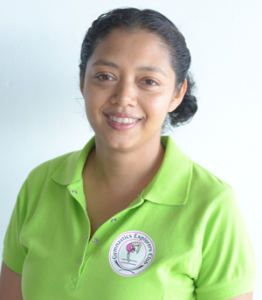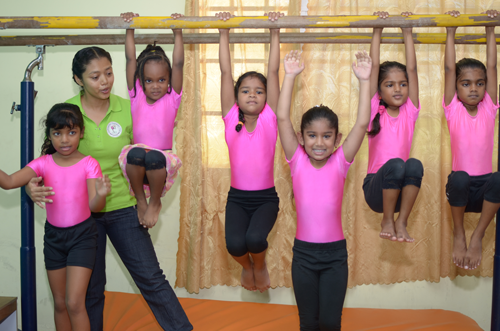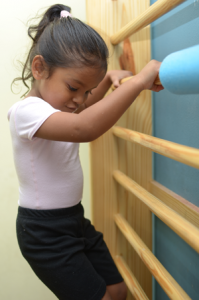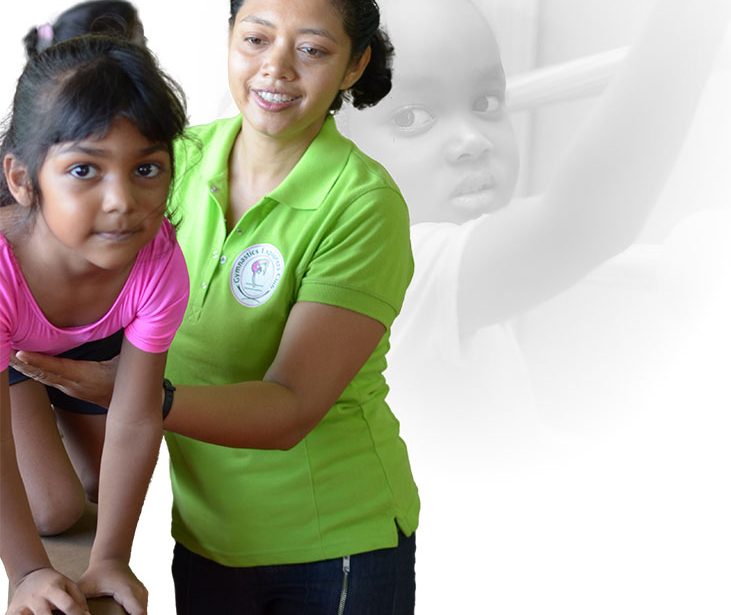“To watch a child come in stumbling… and then be able to stand and go straight into a pose — to go from barely being able to balance, to being so graceful — it takes your breath away.” – Johanna Simon
Tucked away in a corner of Old Longdenville Main Road in Chaguanas is a large open studio, replete with floor mats, automobile tyres and various balance and coordination apparatuses — and a suitcase full of toys.
Gymnastics Explorers is not your usual club. A virtually unknown entity until they struck gold recently at the Caribbean Classic 2013 and the National Invitational Gymnastics Competition, the Club has been in existence for over 13 years.
It began in Johanna Simon’s garage, as she practiced in the view of curious passersby, who voiced that they wished that there was an outlet for their children in the area since most youth activities were based in Port of Spain.

Johanna, who has been involved in various sports since early childhood and has even represented the country at the national level in Shotokan karate, has various qualifications to her name — a professional Canadian coaching course, a judging course, and safety certifications, to name a few. Despite her accomplishments, she shrugs modestly as she reflects upon the early days of establishing the Club, with the support of her husband Simon Siewsarran.
As the Club grew larger, it eventually moved to where it is today — and its membership stands at about 70 children, all of whom came to the Club via word-of-mouth.
“My coach donated a balance beam, and my home became too small for the school,” she reminisces. “The principal of Carapichaima Junior Secondary allowed us to have the equipment there, where we were for a year or two.”
An Outlet for Young Children
“This was never about a money-making venture — we don’t advertise,” explains her husband Simon. “We were looking for an outlet for our own two girls, and I got involved because it is so fulfilling to work with kids — their eyes light up when they accomplish something; it’s amazing.”
Their eyes light up when they accomplish something; it’s amazingIt’s also not just about the sport, as he points out — many of ‘their kids’, as he refers to them, have attained academic scholarships, and excelled in various fields within the world of work. They frequently attribute their success to the structure of extracurricular activities that they attained from a young age at the Club.
“We give them a healthy outlook on life,” Johanna explains. “Self-esteem, understanding who you are as a person, and what you are capable of doing. It’s more than just running and jumping; it’s about how you use all your body parts in cohesion and coordinate it all together, as well as there is a mental component.”
To show the newcomers, Johanna often brings in one of the older children who are at competitive level, to demonstrate the ‘finished product’, and then breaks down the task at hand into smaller goals for the children to learn in stages.
“This applies to life as well,” Simon adds. “Gymnastics is a foundational sport. You can branch into anything else once you have that control.”
Working with Little Gymnasts
Of course, working with tiny developing bodies is very different to coaching an adult.

One of the first things the children learn is how to work with their own body strength, and test the limits of their flexibility — which is easier to learn at an early age, as children’s bodies are still developing muscle connections.
The Club, which takes members from 18 months to 12 years of age, divides students into groups based on age and ability. All the boys are in one group as they do different activities to the girls — more tumbling, strength and flexibility; as opposed to the girls’ activities of graceful ballet-like movements. Children under the age of five all belong to the same group. Apart from these, groupings are done based on ability.
“Children are so different in terms of physical and mental development,” explains Johanna.
“They develop at different rates, so bone structure may differ despite being the same age. Then, you tell some of them something and they get it immediately; others may be older but still need a lot more work to figure something out — part of it will always come down to individual natural ability.”
A Bond between Parent and Child
To enable individual attention, classes are kept small.

A class usually has 12-15 children, except for the preschoolers class which can be larger since parents are required to stay with their children on each apparatus.
However, the link between parent and child is crucial despite the child’s age.
“We work with parents to develop a bond between the parents and kids,” Johanna says. “We prefer parents to stay and see what their child is doing, as they will have questions. Many of them have a fear of ‘Oh my God, my child is going to break her neck!’ but once they stay and look on, they will realise this is not the case at all.”
“We also think it’s important for parents to be able to help their children,” Simon adds. “By seeing them at the Club, they know how to correct the child when they practice at home — so it’s an extra safety measure as well.”
A Well-rounded Picture of Health
They also ensure that the children have a good foundation of general health and wellness knowledge beyond just gymnastics.
“We teach children about proper posture, which needs to be maintained even when they’re not exercising, and how to position your body to avoid injury if you fall — all these little things children may not learn naturally nowadays,” Simon says. “Children aren’t outside as much as they used to be in previous generations, so a lot of these abilities need to be formally learnt.”
“Also,” adds Johanna, “we encourage them to eat fruits and drink lots of water, and we never serve sodas at our events. We also teach them about the importance of having a good night’s sleep, and discourage them from eating too late at night.”
But above all, what they strive to teach the children is, quite simply, how to have fun.
What they strive to teach the children is, quite simply, how to have fun.“A child may resist something if the parent pressures him,” Simon says. “So we try to make it fun. The earlier you get involved in a sport, the bug just gets you — but you have to enjoy it.”
Johanna points at the hanging bar, which has a colourful toy dangling at one end. “It’s children we’re dealing with, so we are very creative,” she says.
“Once it’s fun, the kids look forward to it. And while we have recently started competing, we are not competition-based. If they have the ability and want to do it, they can join the elite class and go to that level. But many of the kids just come here to run around and have a good time — and that’s all that matters!”
Further Information
- Unless your child has prior gymnastics experience, Johanna won’t take anyone above the age of 12.
- Gymnastics isn’t the only thing they do — Johanna has also started a music class, and is open to other ideas about activities for young children.

